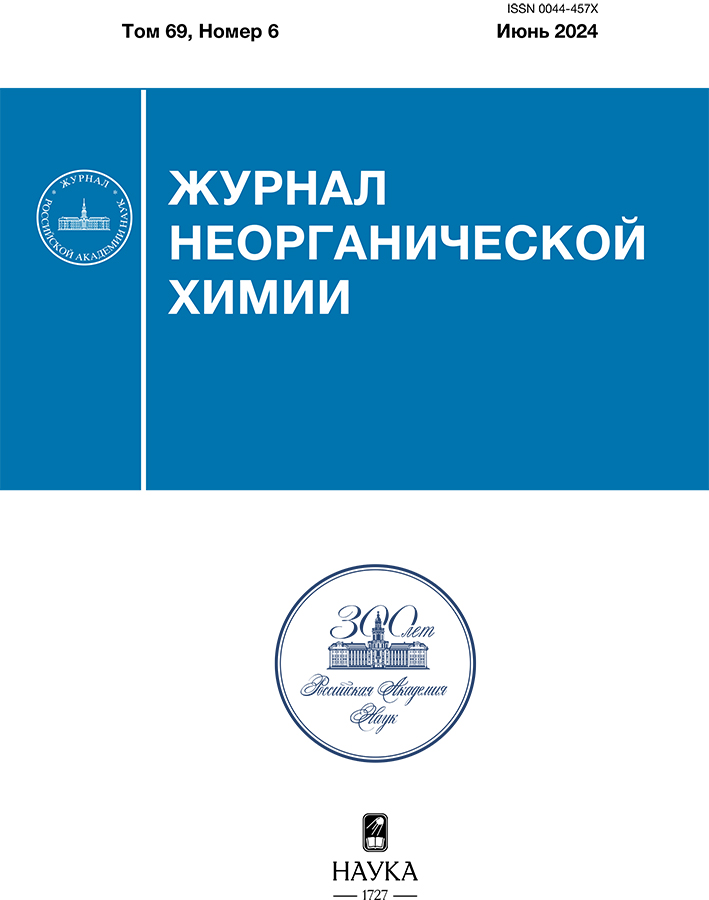Том 69, № 6 (2024)
СИНТЕЗ И СВОЙСТВА НЕОРГАНИЧЕСКИХ СОЕДИНЕНИЙ
Синтез конъюгата клозо-додекаборатного аниона с этилглицинатом и изучение его биораспределения на модели меланомы B16F10
Аннотация
Предложен метод синтеза амидин-клозо-додекабората на основе этилового эфира глицина в виде сольвата натриевой соли высокой степени чистоты и постоянного состава. Структура полученного сольвата подтверждена методом РСА монокристалла. Для синтезированного конъюгата Na[B12H11 NH=C(NHCH2COOC2H5)CH3] определена общая и острая токсичность, а также биораспределение в организме лабораторных мышей с перевивной меланомой B16F10.
 803-809
803-809


Синтез новых борсодержащих лигандов на основе процессов нуклеофильного присоединения 1,10-фенантролин-5-амина к нитрилиевым производным [2-B10H9NCR]– (R = Me, Et, nPr)
Аннотация
Получен ряд замещенных производных клозо-декаборатного аниона и 1,10-фенантролин-5-амина. Строение продуктов установлено методами мультиядерной ЯМР-спектроскопии, ESI-масс-спектрометрии и ИК-спектроскопии. Структура соединения (NBu4)[2-B10H9NHC(C2H5)HNC12H7N2] была установлена методом РСА монокристалла.
 810-815
810-815


Изучение обратимой перегруппировки Хоторна между изомерными формами октадекагидроэйкозаборатного аниона методом динамической 11В ЯМР-спектроскопии
Аннотация
Методом 11В ЯМР-спектроскопии изучен процесс перегруппировки октадекагидроэйкозаборатного аниона [транс-B20H18]2– → [изо-B20H18]2– в различных растворителях (ацетонитрил, ДМФА, ДМСО) под действием УФ-облучения в динамике. Показано, что время полного изомерного перехода зависит от используемого растворителя. В ацетонитриле полная конверсия аниона [транс-B20H18]2– в изо-форму достигается за 1 ч, в ДМФА процесс занимает ⁓2 ч, в ДМСО – ⁓3 ч. Изучен обратный процесс перегруппировки макрополиэдрического бороводородного аниона [изо-B20H18]2– → [транс-B20H18]2– под действием температуры в ДМФА и показано, что увеличение времени реакции и повышение температуры реакционного раствора сопровождаются деградацией борного кластера.
 816-821
816-821


КООРДИНАЦИОННЫЕ СОЕДИНЕНИЯ
Синтез и строение галогенидных комплексов серебра [Ph3PCH=CH2]n[Ag2Br3]n, [Ph3PCH=CH2]n[Ag5Br6]n и [Ph3PCH2CH=CHCH2PPh3][Ag2I4]
Аннотация
Взаимодействием в ДМСО бромида серебра с бромидами (2-бромэтил)- и винилтрифенилфосфония, а также иодида серебра с дииодидом бут-2-ен-1,4-диил-бис(трифенилфосфония) синтезированы галогеноаргентатные комплексы [Ph3PCH=CH2]n[Ag2Br3]n (I), [Ph3PCH=CH2]n[Ag5Br6]n (II) и [Ph3PCH2CH=CHCH2PPh3][Ag2I4] (III). Полученные продукты охарактеризованы методами ИК-спектроскопии и рентгеноструктурного анализа (CCDC № 2330003 (I), 2172944 (II), 1985085 (III)). По данным РСА, соединения I–III состоят из катионов органилтрифенилфосфония с тетраэдрически-координированными атомами фосфора и соответствующих галогеноаргентатных анионов 1D-полимерного (I, II) или неполимерного (III) строения. Анионы [Ag2Br3, [Ag5Br6 “сшиты” из тетраэдрических {AgBr4}-фрагментов, в то время как [Ag2I4]2– – из двух тригональных фрагментов {AgI3}. Во всех полученных комплексах Ag-ядра дополнительно связаны между собой аргентофильными контактами с расстояниями Ag···Ag в интервале 2.8162(12)–3.371(2) Å.
 822-828
822-828


Химическое генерирование и реакционная способность высокоокисленных оксоформ µ-карбидодимерного водорастворимого сульфофталоцианината рутения(IV)
Аннотация
Спектральными методами исследовано химическое генерирование высокоокисленных форм µ-карбидодимерным водорастворимым сульфофталоцианинатом рутения в реакции с трет-бутилгидропероксидом. Установлены закономерности и предложен механизм образования активных частиц. Отмечено, что координирующая способность димерного комплекса определяет возможность образования π-катион-радикала и дикатион-дирадикала. Показано влияние концентрации пероксида и рН среды на генерирование активных форм различного типа, способных окислять не только синтетический краситель, но и органический пероксид.
 829-843
829-843


Кристаллическая структура твердых продуктов взаимодействия ε-капролактама с кремнефтороводородной кислотой и гексафторосиликатом меди(II)
Аннотация
Получены из водных растворов и изучены методами химического, ИК-спектроскопического и рентгеноструктурного анализов новые соединения составов (HOOC(CH2)5NH3)2SiF6 (1) и [Cu(Cpl)2(H2O)2SiF6] · 2Cpl (2), где Cpl – ɛ-капролактам, ɛ-C6H11NO, (HOOC(CH2)5NH3)+ – катион 5-карбоксипентиламмония. В структуре соединения 1 координационное окружение атома Si представляет собой практически правильный октаэдр. Кристаллы триклинной сингонии, пр. гр. P. В ходе кристаллизации капролактам подвергается реакции гидратации и протонированию. В структуре 1 между SiF62–-анионами и органическими катионами обнаружены водородные связи F…Н–N, а также “кислые” водородные связи между карбоксильными группами катионов. Соединение 2 кристаллизуется в триклинной сингонии, пр. гр. P, и имеет полимерное цепочечное строение. Координационный полиэдр двух независимых катионов меди представляет собой тетрагонально-искаженный октаэдр, образованный атомами О двух молекул Cpl и двумя атомами F гексафторосиликат-анионов, выступающих в роли мостиков между соседними катионами. Координационное окружение атома Si – слегка искаженный октаэдр. В структуре присутствуют водородные связи между атомами H координированных молекул воды и атомами О некоординированных молекул Cpl. Геометрия гексафторосиликат-анионов в структурах 1 и 2 идентична.
 844-852
844-852


ТЕОРЕТИЧЕСКАЯ НЕОРГАНИЧЕСКАЯ ХИМИЯ
Квантово-химическое моделирование отщепления молекулярного водорода от диаммиаката борогидрида магния
Аннотация
В рамках кластерного подхода с использованием базиса 6‒31G* и гибридного функционала плотности (B3LYP) выполнено моделирование последовательного отрыва Н2 от комплексов (Mg(BH4)2∙2NH3)2 и (Mg(BH4)2∙2NH3)4. Найдено, что начальный этап дегидрирования требует преодоления энергетических барьеров ~1.5‒1.2 эВ, для этого необходим предварительный нагрев, далее процесс может идти с выделением энергии до извлечения ⁓10 мас. %Н2, для более высокой степени конверсии потребуются дополнительные затраты энергии, превышающие теплоту сгорания Н2 при его извлечении ⁓12.5 мас. %, поэтому дальнейшее дегидрирование этого соединения может оказаться нецелесообразным с энергетической точки зрения.
 853-865
853-865


ФИЗИЧЕСКИЕ МЕТОДЫ ИССЛЕДОВАНИЯ
Теплоемкость и термическое расширение LaMgAl11O19
Аннотация
Методами релаксационной, адиабатической и дифференциальной сканирующей калориметрии измерена теплоемкость LaMgAl11O19 со структурой магнетоплюмбита в интервале температур 7–1865 K. Полученные температурные зависимости теплоемкости согласованы на основании данных адиабатической калориметрии. По сглаженным значениям рассчитаны термодинамические функции (энтропия, изменение энтальпии, приведенная энергия Гиббса) в области 0–1865 K. Методом высокотемпературной рентгеновской дифракции изучено термическое расширение в области 300–1200 K и вычислен коэффициент термического расширения LaMgAl11O19.
 866-873
866-873


ФИЗИКО-ХИМИЧЕСКИЙ АНАЛИЗ НЕОРГАНИЧЕСКИХ СИСТЕМ
Моделирование фазового комплекса стабильного пентатопа LiF–K2CrO4–Rb2CrO4–KF–RbF четырехкомпонентной взаимной системы Li+,K+,Rb+||F–,CrO
Аннотация
Изучена квазичетырехкомпонентная система LiF–K2CrO4–Rb2CrO4–KF–RbF, которая является стабильным пентатопом четырехкомпонентной взаимной системы Li+,K+,Rb+||F–,CrO. Осуществлено прогнозирование нон- и моновариантных равновесий в системе при помощи схемы моновариантных равновесий: в системе осуществляется эвтектическое равновесие L ⇄ LiF + KxRb1–xF + + α-K2xRb2–2xCrO4 + α-K3xRb3–3xFCrO4, которое подтверждено дифференциальным термическим анализом. Данная схема позволяет спрогнозировать нон- и моновариантные равновесия на основе анализа ограняющих систем. Выявлены состав и температура плавления смеси, отвечающей четырехкомпонентной эвтектике E□ 438. На основе полученных данных построена компьютерная 3D-модель фазового комплекса системы в виде концентрационного пентатопа. Компьютерная модель наглядно демонстрирует фазовые превращения в системе. Выявлено строение пространственной фазовой диаграммы. В системе кристаллизующимися фазами являются фторид лития, три фазы непрерывных рядов твердых растворов: на основе фторидов калия и рубидия – KxRb1–xF, на основе хроматов калия и рубидия в α-полиморфной модификации – α-K2xRb2–2xCrO4, на основе фторид-хроматов калия и рубидия в α-полиморфной модификации – α-K3xRb3–3xFCrO4.
 874-883
874-883


Политерма растворимости системы Mg(ClO3)2– [21% ClCH2CH2PO(OH)2 ∙ NH3 + 11% ClCH2CH2PO(OH)2 ∙ 2NH3 + 12% NH4H2PO4 + 56% Н2О]–H2O
Аннотация
Изучена растворимость в разрезе сложной водной системы, состоящей из хлорэтилфосфонатов, фосфата аммония и хлората магния, в интервале температур от –66.8 до 12.4°С. Построена политермическая фазовая диаграмма, на которой разграничены поля кристаллизации льда, шести-, четырех-, двухводного хлората магния, препарата “Нажот”, состав которого [21% ClCH2CH2PO(OH)2 · NH3 + 11% ClCH2CH2PO(OH)2 · 2NH3 + 12% NH4H2PO4 + 56% Н2О], и соединения – хлорэтилфосфонатмонохлората аммония NH4ClO3, ClCH2CH2HPO3NH4. Состав соединения подтвержден методами химического и физико-химического анализа.
 884-890
884-890


ФИЗИКОХИМИЯ РАСТВОРОВ
Определение условий селективной сорбции серебра(I) на тиокарбамоилированном полиэтилене
Аннотация
Исследованы сорбционные свойства тиокарбамоилированного полиэтилена по отношению к серебру(I) из многокомпонентных растворов. Установлено, что синтезированный сорбент характеризуется высокой сорбционной емкостью и селективностью по отношению к ионам серебра. В статическом режиме сорбции количественное извлечение возможно из растворов с концентрацией Ag(I) 1 × 10–4 моль/л в диапазоне рН от 1 до 7, при этом сопутствующие Сa(II), Mg(II), Cu(II), Fe(III), Zn(II), Cd(II), Ni(II), Mn(II), Co(II) и Pb(II) не оказывают влияния на степень извлечения ионов серебра. Высокая селективность сорбции сохраняется и в динамических условиях в присутствии избыточных количеств ионов неблагородных металлов при рН 2. Полная динамическая сорбционная емкость по серебру составляет 0.35 ммоль/г (скорость пропускания раствора 2 см3/мин, рН 2, масса сорбента 0.1 г, С = 1 × 10–4 моль/л). Определен состав элюентов, обеспечивающих наибольшие значения степени десорбции серебра с поверхности сорбента. Установлено, что при проведении сорбции с использованием сорбента после стадии сорбции–десорбции его емкость по серебру уменьшается незначительно.
 891-898
891-898


О фосфинсодержащих комплексах золота(I) в растворе в связи с их биологическим применением
Аннотация
Рассмотрены некоторые превращения с участием AuCl(PPh3) в CH3CN/H2O-растворе и выполнено сравнение с известными данными для ауранофина. Взаимодействие с GSH ведет к образованию биядерного (GSH)[Au(PPh3)]2 (при CGSH/CAu < 0.5) или моноядерного Au(GSH)(PPh3) (CGSH/CAu > 0.5) комплекса, замещение PPh3 не наблюдается. Взаимодействие с BSA ведет к замещению Cl–. Исследование с помощью циклической вольтамперометрии показало наличие нескольких пиков необратимого окисления AuCl(PPh3) и комплексов с GSH.
 899-906
899-906


НЕОРГАНИЧЕСКИЕ МАТЕРИАЛЫ И НАНОМАТЕРИАЛЫ
Металл-органическая каркасная структура на основе никеля, триптофана и бипиридилэтилена, консолидированная на трековой мембране
Аннотация
Разработан подход к модифицированию трековой мембраны металл-органической каркасной структурой на основе никеля, L-триптофана и 1,2-бис(4-пиридил)этилена. Исследовано влияние заряда поверхности ТМ на процесс самосборки Ni-МОКС. Установлено, что микроструктура Ni-МОКС не зависит от способа модифицирования ТМ. Самосборка Ni-МОКС на ТМ, модифицированной нановолокнами из хитозана, является наиболее перспективным подходом к созданию композита ТМ и Ni-МОКС, поскольку не снижает эксплуатационные качества мембраны. Методами растровой электронной микроскопии, рентгеноструктурного анализа, рентгеновской фотоэлектронной и ИК-спектроскопии показано, что состав и структура Ni-МОКС в свободном состоянии (в виде порошка) и в составе консолидированного материала идентичны. Анализ спектров рентгеновской фотоэлектронной спектроскопии порошков Ni-МОКС после контакта с растворами солей Cd, Cu, Cs и изучение кинетики сорбции ионов Cd, Li, Ag, Zn, Mg и Li показали, что Ni-МОКС может являться потенциальным сорбентом ионов металлов.
 907-918
907-918


Фотоактивные слои на основе наностержней ZnO, полученных гидротермальным синтезом, для сенсибилизированных красителями солнечных элементов
Аннотация
Рассмотрено применение наностержней оксида цинка ZnO различной высоты, полученных гидротермальным синтезом, в качестве функциональных слоев для сенсибилизированных красителем солнечных элементов. Структура, морфология и оптические свойства слоев наностержней были исследованы методами рентгенофазового анализа, сканирующей электронной микроскопии, оптической спектроскопии. Изготовлены фотоаноды с использованием красителей на основе тиено[3,2-b]индола IS 4 и IS 9. Механизм адсорбции красителей и структур ZnO был изучен методом ИК-спектроскопии. С помощью фотоэлектрохимических измерений была исследована эффективность работы фотоанодов. Показана зависимость эффективности сенсибилизированных красителем солнечных элементов от длины наностержней. Максимальный результат преобразования света был получен для фотоанода со средней высотой наностержней 2.5 мкм и адсорбированным красителем IS 4.
 919-927
919-927


Структура и фотокаталитическая активность композитов из наночастиц полупроводников в полиметилметакрилате
Аннотация
Синтезированы и исследованы композиты из наночастиц (20–100 нм) диоксида титана (TiO2), оксида цинка (ZnO) или графитоподобного нитрида углерода (g-C3N4) в полиметилметакрилате. В качестве исходных материалов использовали нанодисперсные порошки этих полупроводников, которые в весовом соотношении от 1 : 5 до 1 : 20 смешивали с механически измельченным PMMA. Полученную смесь растворяли в ацетоне и наносили на поверхность воды. Ее затвердевание и последующая сушка на воздухе обеспечивали создание пористых дискообразных пластинок толщиной 50–200 мкм из синтезированных композитов. Они механически прочны при доле наполнителя, не превышающей 1 : 20. Сканирующей электронной микроскопией, энергодисперсионной рентгеновской спектроскопей и рентгеновской дифрактометрией установлено, что в созданных композитах наночастицы полупроводников квазиравномерно распределены в полимерной матрице. Их кристаллическая структура, размер и состав не претерпевают заметных изменений по сравнению с исходными порошками. Фотокаталитическая активность синтезированных композитов, оцененная по обесцвечиванию водного раствора тестового красителя (метиленового синего) под действием ультрафиолетового излучения, убывает в ряду TiO2, g-C3N4, ZnO.
 928-934
928-934


Синтез, структура и оптические свойства полупроводниковых перовскитных наночастиц CsBX3 (B = Pb, Mn; X = Br, Cl)
Аннотация
Предложена модифицированная методика получения перовскитных наночастиц с частичной заменой свинца на марганец. Представлены данные о структуре, форме и размере полученных наночастиц, а также приведены результаты ЭПР-спектроскопии, указывающие на наличие парамагнитных центров. Это позволило сформулировать предположение о механизме вхождения в структуру перовскита ионов Mn со степенью окисления +2. Показано влияние частичной замены свинца на марганец на оптические свойства перовскитных частиц, в частности, на появление новых люминесцентных полос в области 600 нм.
 935-944
935-944













